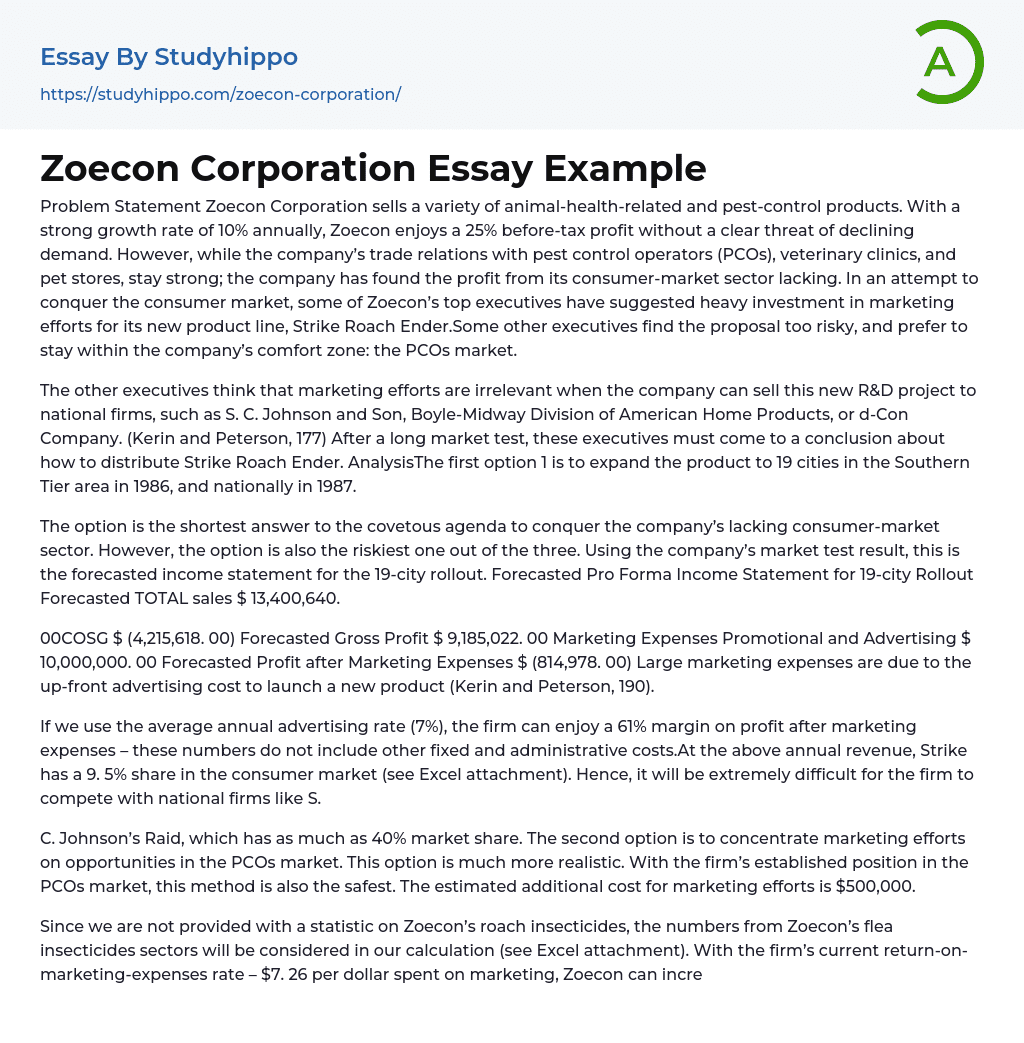Concerns have been raised about Zoecon Corporation's lack of profit in the consumer-market sector, despite enjoying a 10% annual growth rate and a strong trade relationship with pest control operators, veterinary clinics, and pet stores. Currently, the company's before-tax profit is at 25% without any indication of diminishing demand. Some executives have suggested investing heavily in marketing efforts for their new product line, Strike Roach Ender to conquer the consumer market. However, others oppose this idea due to the risks involved and prefer to stick to the company's safe haven within the PCOs market.
The executives believe that marketing is unnecessary since the R;D project can be sold to national firms (S. C. Johnson and Son, Boyle-Midway Division of American Home Products, or d-Con Company) (Kerin and Peterson, 177). They must decide how to distribute Strike Roach Ender after a lengthy market test.
...One choice is to introduce the product to 19 cities in the Southern Tier region in 1986 and expand nationally in 1987.
The shortest solution to capture the company's unmet consumer-market section is also the most hazardous among the available three options. Based on the market test outcomes of the company, here is the anticipated income statement for the rollout in 19 cities: Forecasted Pro Forma Income Statement for 19-city Rollout Forecasted TOTAL sales $ 13,400,640.
Forecasted Gross Profit: $4,215,618.00. Forecasted Profit after Marketing Expenses: $(814,978.00). Marketing Expenses: Promotional and Advertising: $10,000,000.00. The high marketing expenses are a result of the initial advertising cost required for the launch of a new product (Kerin and Peterson, 190).
Assuming a 7% average annual advertising rate, the company can achieve a 61% profit margin after accounting for marketing expenses.
However, this calculation does not include other administrative costs. According to the attached Excel spreadsheet, Strike's consumer market share is currently 9.5%. Given this level of revenue, it may prove challenging for the firm to compete with larger nationwide companies such as S.
One option is to focus on promoting C. Johnson's Raid, which currently holds a significant 40% market share. However, concentrating on opportunities in the PCOs market is the more practical and secure choice, given the firm's established position in that market. This option would require an estimated $500,000 for additional marketing efforts.
To calculate the potential increase in Zoecon's market share, we will use the statistics from Zoecon's flea insecticides sectors, since there is no data available on their roach insecticides (see Excel attachment). With a current return-on-marketing-expenses rate of $7.26 per dollar spent, Zoecon can raise its current market share by 1% – from 18% to 19%. Another option for Zoecon is to sell IRG to national firms that are heavily involved in the consumer market sector. This route offers a profit margin of 50% and eliminates any marketing expenses for Zoecon.
The executives of Zoecon must consider their market position carefully before compromising their opportunities in the consumer market. While developing the product image of Strike, Zoecon can achieve a profit margin of up to 61% after marketing expenses. Therefore, to retain their market share in the PCOs market and gain opportunities in the consumer market sector, Zoecon should combine option 1 and 2. Selling Strike nationwide is only risky in the first few years, as explained above.
Once the product gains its reputation, there will be a satisfactory margin
for the company. It is advisable for Zoecon to remain in the PCOs market due to its existing relations with other PCOs businesses. However, the extra $500,000 is not significant enough to generate a substantial increase in market share. Zoecon should also contemplate renaming Strike Roach Ender to distinguish their professional line from their consumer-market line.
- Chief Executive Officer essays
- Convenience Store essays
- Firm essays
- Training And Development essays
- Unilever essays
- Variable Cost essays
- Virgin Group essays
- Bargaining essays
- Entity essays
- Pest analysis essays
- Company essays
- General Motors essays
- Bmw essays
- Ford Motor Company essays
- Honda essays
- Toyota essays
- Volkswagen essays
- Amazon essays
- Apple essays
- Enron essays
- Tesco essays
- Ibm essays
- Costco essays
- Kellogg essays
- Ikea essays
- Iphone essays
- Supermarket essays
- Gap essays
- Walmart essays
- Adidas essays
- Red Bull essays
- Pepsi essays
- Coca-Cola essays
- Burger King essays
- Kfc essays
- Mcdonald's essays
- Key essays
- British Airways essays
- Nokia essays
- Facebook essays
- Myspace essays
- Twitter essays
- Google essays
- Microsoft essays
- Ryanair essays
- Southwest Airlines essays
- Johnson and Johnson essays
- Sony essays
- Ebay essays
- Pepsico essays




